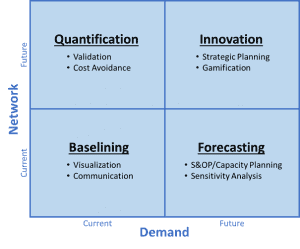What if you could accurately predict how your supply chain will perform in the future? Know how a strategy change will impact your service levels or costs? Predict when you will stock out or be late with a shipment?
To do this you need ESP. Not extra-sensory perception, but it’s the next best thing from a supply chain analyst’s point of view. Enterprise simulation planning (ESP) enables businesses to see how the supply chain will perform under future demand and potential alternate supply chain structures and policies to reduce the risk inherent in strategy changes and to encourage continuous supply chain improvement and innovation.
The Four Quadrants of Enterprise Simulation Planning
To best illustrate the different use cases for simulation in supply chain analytics, it helps to visualize four quadrants, with two distinct axes and two specific states (time horizons) for planning and testing different variations of current and potential supply chain strategies.
Let’s take a look at how each of the four quadrants plays out in supply chain planning:
Baselining: Current Network / Current Demand
Modeling and simulating the Current Network using the Current Demand (i.e. the most recent historical supply chain transactions) is an essential starting point for all other forms of analysis, and is typically referred to as the “baseline”.
Business Value: Visualization and Communication
The baseline is like the control in a scientific experiment. Once the baseline simulation has been validated to show that the behavior, flows and costs match those that happened in the real world, the analyst achieves confidence in the model’s behavior and can use the model to compare against new simulations that explore changes to structure, policy, or demand. Seeing the as-is supply chain in maps and graphs is a way to identify inefficiencies and other problems, and create a consensus among all stakeholders, minimizing people’s ability to challenge the results of future what-if experiments.
Quantification: Future Network / Current Demand
Simulating the Future Network using Current Demand can help an analyst to quantify a theoretical change to the supply chain structure or policies before implementing such a change in the real world.
Business Value: Validation and Cost Avoidance
Simulating different what-if configurations of the supply chain network can help quantify the cost and service level impact for questions such as: What if we change to twice-weekly replenishment? What if we source from Mexico instead of China? What if we change our inventory targets? Running detailed simulations of these decisions can help companies avoid the costs associated with bad decisions by predicting these costs ahead of time and comparing the results versus other, more appropriate network decisions.
Forecasting: Current Design / Future Demand
Simulating the Current Design using Future (Forecasted) Demand can help an analyst predict operational challenges such as capacity limitations, product stock-outs, delayed deliveries or supply shortages.
Business Value: S&OP and Sensitivity Analysis
Companies spend an enormous amount of time and effort attempting to forecast future demand. These forecasts have varying levels of accuracy, but can be extremely useful when coupled with enterprise simulation planning models. Running simulation scenarios with different potential forecasts can identify the limits a supply chain can handle before running into operational difficulties. For this reason, leading companies often incorporate these simulation models into their corporate S&OP or capacity planning processes.
Innovation: Future Demand / Future Structure
Modeling new supply chain network strategies with new projected demand is required when trying to innovate and proactively move the business forward.
Business Value: Strategic Planning and Gamification
Transformational decisions often do not have a historical reference or transactional history, nor do they always have an existing supply chain network from which to create a model. However, simulating Future Networks with projected Future Demand is incredibly useful in testing transformational ideas such as M&A activity and validating theories prior to making these often risky moves. It also enables companies to try gamification strategies by turning analysts loose to create and test new supply chain designs and encourages innovation and entrepreneurship within the team.
ESP + ERP = ROI
Many companies have adopted simulation technology as part of an integrated supply chain design technology platform. This platform enables automated model building and analysis using data pulled directly from the ERP system, enabling continuous improvement and innovation using the most current operating and reference data. Components of this system include:
Because simulation truly factors time and variability into each individual transaction, decision and movement throughout the supply chain at SKU-level detail, this ESP method is extremely useful as a way to test potential network changes before enacting them, reducing risk of strategy changes and supporting continuous supply chain improvement and innovation. If you’d like to read more, see ESP for the Supply Chain.
Toby Brzoznowski is the Executive Vice President of LLamasoft, Inc. Toby has over 20 years of experience building and growing businesses, focused on process improvement and analysis technologies. His expertise has been applied to bringing new and advanced technologies into mainstream use at global Fortune 500 businesses. In the last decade, Toby has been involved in the start-up of three technology companies. He is a graduate of the University of Michigan and a frequent presenter at supply chain and strategic sourcing events.



















Leave a Reply